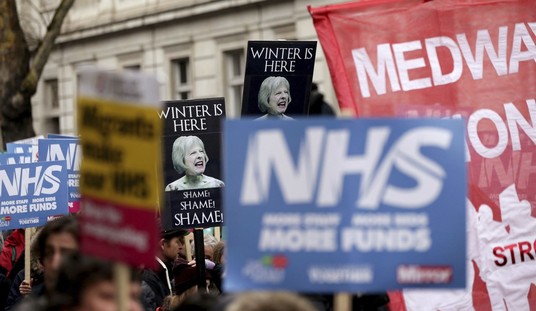The problem all along with treating the entire bloc of Americans without health insurance as a monolith is what brought us ObamaCare in the first place. The massive reorganization of the health-care sector presumed that 40 million (or 48 million, or 37 million) people lacked insurance all for the same reason — obstacles such as pre-existing conditions or economic hardship. A great many of those were either transitionally uninsured or uninsured by choice. Not surprisingly, a new survey shows that a significant number still don’t want to pay for health insurance, mandates notwithstanding:
A new report finds that one in three Americans who do not have health insurance plan to remain uninsured.
According to the survey done by Bankrate.com, of the 34 percent who say they won’t purchase Obamacare, 41 percent said it was too expensive, 17 percent were against the Affordable Care Act and 13 percent said they were healthy enough not to need coverage.
“It’s hard to generalize, but for some of these folks, it’s a case of, ‘I’m in pretty good health, I don’t think about these things, I know I can’t afford it now,’” Michael Morrisey, professor of health economics at the University of Alabama at Birmingham School of Public Health, told Bankrate.com. “I think it’s just rolling past them, and they’re not giving it a whole lot of attention.”
Only 56 percent polled said they plan to purchase health insurance.
The article then quotes a researcher who thinks that the problem is that the White House didn’t emphasize the penalties hard enough. Well, it’s difficult to emphasize penalties when those keep getting delayed, especially by the same White House that would need to do the emphasizing. The penalty for the individual mandate is all but gone for tax years 2014 and 2015, thanks to the latest unilateral change coming from the Obama administration. Penalties that don’t penalize aren’t really all that motivating.
Besides, the survey itself makes it pretty clear that the refuseniks in this case aren’t making that decision out of sloth. More than 40% of them think ObamaCare is too expensive, and another 13% don’t see the need for comprehensive insurance, which is a majority who see the mandate as so cost-ineffective that it’s worth it to pay the penalty instead. Those are rational decisions, which a significant portion of the uninsured population made prior to ObamaCare, too.
How rational? Paul Bedard reports that an eHealthInsurance survey shows it to be a wise calculation (via Power Line):
According to a cost report from eHealthInsurance, a nationwide online private insurance exchange, families are paying an average of $663 a month and singles $274 a month, far more than before Obamacare kicked in. What’s more, to save money, most buyers are choosing the lowest level of coverage, the so-called “bronze” plans.
The firm provided the costs to Secrets through their new online price index, which gives the averages of what people are paying for insurance sold through their system. In California, for example, some families are paying a high of $2,604 a month and in New York, $1,845. …
— Premiums have increased by 39 percent to 56 percent, compared to pre-Obamacare coverage. As of Feb. 24, the average premium for an individual health plan selected through eHealth without a subsidy was $274 per month, a 39 percent increase over the average individual premium for pre-Obamacare coverage.
— The most recent average premium for plans without a subsidy chosen by families was $663 per month, a 56 percent increase over the average family premium in Feb. 2013, which was $426 per month.
This follows on sharp premium increases since the 2010 passage of ObamaCare, too, after the taxes and mandates for coverage began to kick in for insurers. Families are now spending almost $8,000 for an average policy, and that’s before the deductibles. They will have to spend thousands of dollars more before their benefits actually take effect. The same is true for individuals; at the above average, it’s about $3300 for premiums and thousands more in deductibles. So much for “bending the cost curve downward.”
Let’s remember that this market disruption was ostensibly created to entice all of these uninsured into the system. What rational reason do these costs give them to comply? It’s better to pay the fine and deal with routine care with out-of-pocket payments, then get insured late if a catastrophic event takes place.
Maybe, when we finally scrap this system, we’ll design one that offers real cost savings through open competition and reduced government rationing. In the meantime, no one can blame people for making rational choices, except of course this White House.








Join the conversation as a VIP Member